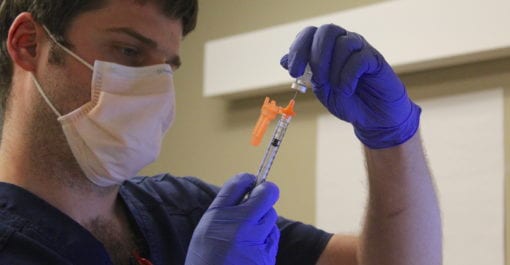Infection
Santa Clara County sees rise in COVID infections
As summer comes to an end, COVID-19 and other serious illnesses look to be on the rise in Santa Clara County.
The county tracks COVID-19 infections through wastewater testing. The coronavirus rating is coming back high across sewer sheds in parts of Santa Clara County such as San Jose and Palo Alto, while Sunnyvale and Gilroy have a medium rating. The newest variant of COVID-19 passing through communities is the XBB.1.5 variant, according to the county.
Dr. Dean Winslow, professor of medicine at Stanford University, said those in vulnerable populations should pay attention to the recent uptick in infections and protect themselves. He said the next round of boosters should be out before the end of September, maybe as soon as next week.
“Older individuals and people who have compromised immune systems can still get very, very sick and die from these infections,” Winslow told San José Spotlight.
Dr. Sarah Rudman, the county’s assistant health officer, said while the county has made major strides in responding to the virus, COVID-19 is being detected at medium to high levels throughout the area. She recommends people wear masks indoors in crowded or high-risk settings, such as health care facilities or nursing homes.
“Taking the steps to protect ourselves, staying up to date on vaccines, wearing masks when we’re indoors and staying away from others when we’re sick helps to keep ourselves safe, our family safe and helps to make sure our health care systems are up and running to take care of everyone who needs them,” Rudman told San José Spotlight.
In the seven days prior to Aug. 28, there was an 8.9% positivity rate for COVID-19 in Santa Clara County. There were 179 new hospital admissions, 28 more than the week before.
Masks have not been required in California’s high-risk setting such as health care facilities, jails, homeless shelters and long-term care homes since April. Health care workers are no longer required to get vaccinated for COVID-19, and people with the virus can end isolation after five days, among other changes rolled out earlier this year.
Santa Clara County has been at the forefront of the country’s governmental response to the coronavirus and was first in the nation to declare COVID-19 a public health emergency on Feb. 10, 2020, when there were two confirmed infections in the county and 13 confirmed nationwide.
Officials are also warning against the rise of Respiratory Syncytial Virus (RSV), as there have been upticks of infection across all sewer sheds in the county, which might be signaling the start of RSV season.
Winslow said the vaccine for RSV is available for those over the age of 65 and for pregnant women, since babies are more susceptible to this virus.
“(The vaccine is) really good news for our pediatric population,” Winslow said. “RSV is a real threat to even babies born at term. They can get very, very sick.”
Rudman said that everyone should take steps to protect themselves from these illnesses so communities can live safely and healthier. She said the best way to prevent these illnesses is to stay up to date on vaccines.
“COVID, flu, RSV and other viruses that circulate in the fall and winter can really just kind of put you down for the count,” Rudman told San José Spotlight. “We want our communities to be healthy so that they can keep going to work, keep going to school (and) enjoy the end of the summer and the beginning of the fall.”
Contact Julia Forrest at [email protected] or follow @juliaforrest35 on Twitter.

